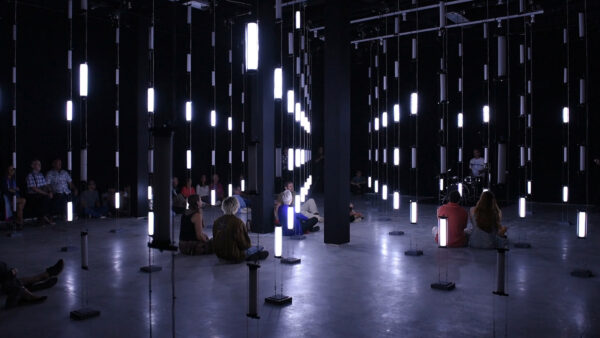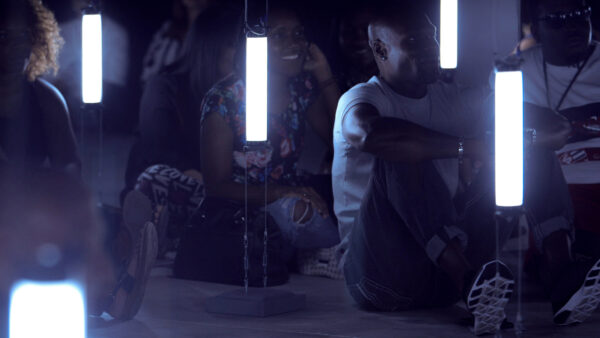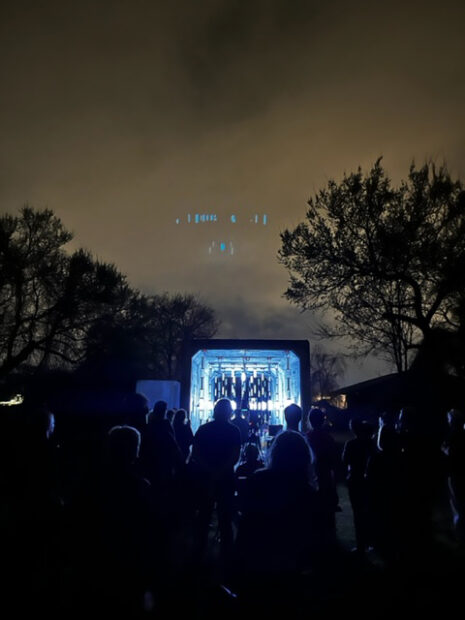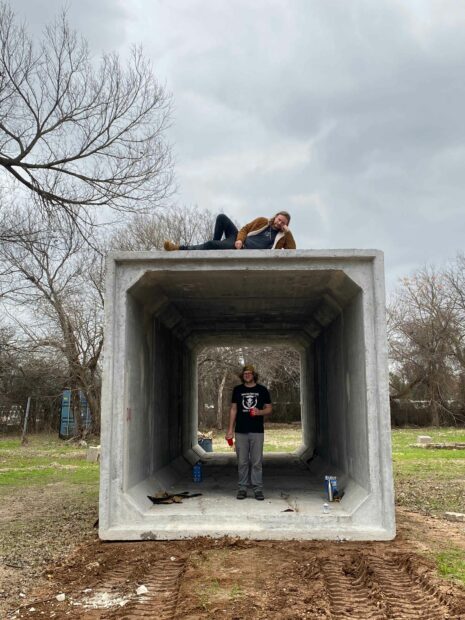
Directors Sean Gaulager and Austin Nelsen on the day the culverts were installed on Co-Lab Projects’ Glissman Prperty.
Since 2007, I have been lucky enough to call Sean Gaulager both a dear friend and collaborator. In 2008, we founded Co-Lab Projects in Austin as a way to fill a niche for younger artists who wanted a space to experiment and collaborate. Over the years, we all have grown up (just a little bit), and Co-Lab has seen a rollercoaster of changes that reflect the ebbs and flows of our own visual arts community in Austin. In 2018, Co-Lab purchased a property on the east side of the city, with the intention to break ground and build its own facility. Then the pandemic happened, pausing these plans and forcing the organization to rethink its space, yet again —something we have become pretty good at throughout the years. The result: a tunnel-like gallery made of five concrete culverts.
In our recent project, VOLUMES by Ezra Masch, we stretched even our own thinking of what an exhibition space can be, which is something we have been talking about within our circle of directors. (Full disclosure, I am still a director — one of five.) Without a doubt, the pandemic forced all of us to pause and think, but as an organization we were lucky to be able to use our assets to their full advantage and really create a space that is challenging, unique, and can be many things — including a work of art in and of itself.
Recently, I had a chance to catch up with both Sean and Ezra about both the Culvert Gallery and VOLUMES, which has a final performance this Saturday, April 23, 2022.
Leslie Moody Castro (LMC): Can you give us some background on how the Culverts happened?
Sean Gaulager (SG): The culvert gallery came to be during the early pandemic period when we were grappling with how to continue presenting programs to in-person audiences of scale. Springdale General [a development in east Austin] was no longer meeting these needs, and the Glissman property, without any structures, had challenging limitations. The culverts offered a way to keep artwork locked up and protected from the elements while allowing audiences to experience an environment without feeling like their health might be compromised. After several inquiries, we lucked out and the cement company next door to the property agreed to donate the culverts to us since they were “out of spec” and could not be sold for subterranean installation. Once we prepared the property for their delivery, they were brought over one-by-one from next door on a massive forklift and installed on a road base pad. After sealing the seams with a few hundred cans of spray foam, Austin Nelsen and I began the design and fabrication of the drawbridge doors/ramps.
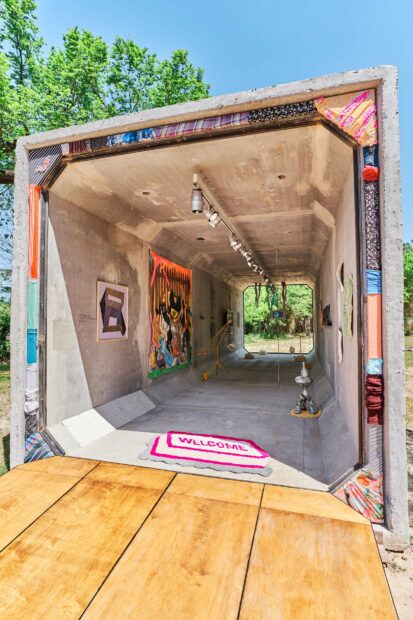
Installation view of “A Wished for and Welcome Guest,” the inaugural group exhibition at the Co-Lab Projects Culvert Gallery. Photo by Ryan Davis.
LMC: You’ve had a few months to get used to working with the Culverts. What are some of the challenges you’ve faced, some of the ways you’ve had to adjust to a raw space, and some of the things that have become really exciting?
SG: It’s been a year already!
LMC: I just made my terrible sense of time very obvious. It’s so hard to believe it’s been more than a year, but yes we installed them in January of 2021! But back to the question…
SG: The main challenge with this space is probably the most obvious, that its materials and rawness can be hard on exhibition planning and on the bodies of those working with it. Although this is not our first time exhibiting in a concrete structure (DEMO [a space Co-Lab occupied on Congress in downtown Austin] was also mostly concrete and very raw) but you quickly forget exactly how much it sucks to drill every single hole with a fucking bulldog hammer drill, especially as we continue to age. What makes this strenuous labor worthwhile is having built a structure/sculpture that is incredibly unique and elicits fascination anytime anyone sees it. The culvert gallery dictates, as all spaces do, how best to use it to present an artistic vision. I see the culvert for what it is: it’s a tunnel, a vessel of passage, a portal that pulls you in and directs you through. Most of the exhibitions so far have been designed and installed to highlight this experience, one of passing through, of traversing from one end to another. In VOLUMES this happens with sound and light.

Installation image of “9/11 Memorial: The 20 Year Anniversary” by Claude van Lingen. Photo by Ryan Davis
LMC: Once they were installed, how did the Culverts introduce a new way of thinking about exhibition space?
SG: I don’t necessarily think there’s anything new about how we’re approaching this space versus how we think about our spaces more broadly. As you are very familiar with, LMC, with each iteration/situation of the organization, Co-Lab has designed its programs to address the needs of the cultural community as well as adapt to and maximize the spaces we find ourselves in. We thrive in the unconventional. Sure we can do some cool shit in a white cube, but where we really shine is when we have some spatial challenges, contextual limitations, and architectural oddity. I still really wish we had been able to do an exhibition in that old male strip club, La Bare.
LMC: It’s true that we have evolved our own definition of space and site specificity over the years, but more than ever, we’ve had so many conversations about looking at this one space as a sculpture and thinking about it in terms of an object, environment, something to be destroyed, and in this case, an instrument. We came from a lovely little white cube with buttery new walls, and it takes time to transition to thinking about how to work with and treat spaces. How did you wrap your mind around curating for the culverts and the possibilities that exist within them?
SG: In thinking about what purpose the culverts were going to serve, we first looked to our programmatic history and the kinds of spaces we’ve curated in the past. Despite having recently had access to some sweet sweet buttery new walls, we originally had a space not all too different from the current one — a bare-bones piece of architecture on an open piece of property with room for people to gather and wander. It definitely feels like our first home in many ways. In our early discussions about pivoting our full attention to Glissman, we could see and feel the linkage between the two sites. Additionally DEMO, or 721 Congress, had similar attributes to the culverts, with its imposing concrete walls and rugged unfinished feel.
Curatorially, I’m thinking about all these things as a holistic experience and then drawing from each to assemble a program that functions optimally in the present, utilizing the current tools at hand. My “practice” is very hands-on in the sense that I’m generally working with the artists we exhibit in a very direct way and am involved in nearly every element of the planning and execution of their installations. For me, learning how to program a space goes hand in hand with how to build or modify one. The conceptualization happens in tandem with labor; as we were building the culverts, all this stuff was beginning to form in my head about what works in a tunnel, how this isn’t merely a gallery or architecture but a sculpture as well (as you mentioned), and how it’s incredibly specific in its aesthetic qualities and therefore requires an equally specific pairing with the work that will displayed within. What sculptures (or other artworks) do you place inside your sculpture? I suppose this is what you were getting at in asking me what differs. I had not yet truly built a new space to show work in, especially not one that commands such consideration.
LMC: This leads us to the current project, how did the conversation about VOLUMES happen?
SG: Weren’t you there? Pretty sure you were there…
LMC:…I’m asking for those who were not there (and I’m pretty sure I was playing with your dog, Shug, while the conversation was happening).
SG: I’ve been a fan of Ezra Masch’s work since he was in grad school at UT back in 2012ish times. I saw the first iteration of VOLUMES in the sculpture sheds behind the art building and was enthralled. After he graduated and moved away, I’d catch little glimpses from afar of what he was doing and how the piece was evolving — a video from the Ringling Museum really stuck in my brain. After he moved back to Austin, we reconnected when he came to one of the exhibitions last summer, and in talking about the space and thinking out loud about 2022 and our desire to do something sonically with the culverts, it kind of dawned on all of us that VOLUMES would be perfect for the space. Once we had a budget green lit there were daily conversations between myself and Ezra to figure out layout, technical needs and challenges, and scheduling. We also began to build lists of performers and asked for recs from people like Zac Traeger, Sean Ripple, Zach Goldman, and others. There were so many amazing drummers to choose from; it was hard to narrow it down to a program that covered a range of musical genres and paired different kinds of percussionists together to create dynamic experiences for the audience. Our intent with this piece was to open 2022 strong, to present a program packed with as many events as we, and Ezra, could reasonably handle, and to showcase the possibilities of the culverts as a sonic venue in addition to a functional gallery space.
LMC: Ezra, you’ve got a background in music, can you tell us how you transitioned from music to visual art/exhibitions, and how the two inform each other in your practice now?
Ezra Masch: I started playing piano at the age of six and I started drawing incessantly around the same time. Visual art and music have always kind of gone together for me. But for most of my life they were separate creative practices. I played drums in a band and wrote songs on piano. I went to art school and studied figurative sculpture. I was working with clay and bronze when I started the grad program at UT. The art building was right across the street from the Butler School of Music. I’d take frequent breaks from my studio to go and play piano in the practice rooms there. Eventually something clicked and I felt really motivated to create some sort of visual music. I’m actually surprised that it didn’t happen sooner. I’m self-taught when it comes to piano and I have always thought about the music I make in visual terms. I think of the intervals between notes as shapes and patterns. Sounds resemble visual textures and colors. This way of thinking was nothing new to me, but I just didn’t know how to translate it into a physical form yet. I did some research and learned that audio-visual instruments have been around for centuries. One of my first experiments with light and sound was based on the Clavecin Oculaire, invented in 1725. The device used the key levers of a harpsichord to raise and lower bands of colorful paper that were illuminated by candlelight. I created a similar effect using my Fender Rhodes electric piano. Each individual key controlled a separate electrical circuit, and each octave represented the chromatic range of the spectrum. That sort of started it all. Now I have been doing these audio-visual projects for the past 10 years.
LMC: You’ve also installed this project in a number of spaces; can you tell us a few highlights of the other iterations, and what makes the piece at Co-Lab unique?
EM: One of the first iterations of the project took place in a warehouse in Philadelphia (that’s where I grew up). It was a very under-the-radar situation, and it was short-lived as well because the police showed up and we had to abruptly vacate the premises. But I went on to create similar installations in established art venues, including the Icebox Project Space (also in Philadelphia) and the Ringling Museum of Art in Sarasota, Florida. Each of these installations has been unique. The layout, the number of lights, and the spaces between them are all dictated by the interior dimensions of the architecture. The concrete culvert structure at Co-Lab is really different from the spaces I’ve worked in previously though. It’s more like a utilitarian object than a building. It has been interesting to watch percussionists engage with it as an object. And because it’s open on both ends, audiences have been able to view performances from either the inside or the outside. Another way this show at Co-Lab is different is that it’s running for 2 months, which is much longer than any of the previous iterations. This extended timeframe has allowed me to work with more people, to experiment more, and to explore new directions for this audio-visual instrument.
LMC: Ezra, can you elaborate on what you mentioned earlier about this idea of VOLUMES as an audio-visual instrument? How do you think it will allow the project to evolve?
EM: With VOLUMES, live sound from the drums is translated into coordinates within a 3-dimensional grid of lights. Frequency is represented along the vertical axis while amplitude is represented horizontally. When percussionists play the piece they are improvising and composing with light and space, as well as sound. Visual shapes, patterns, and textures influence their ideas and creative direction as they play. It’s sort of reciprocal. That’s why I call it an audio-visual instrument. Because the experience of sound and image are connected, both in terms of perception and in terms of creation.
LMC: Tell us about some other ways music has manifested in your work and projects.
EM: Most recently I have been making drawings based on images created by sound. Some of my projects are less directly connected to music, but they incorporate a lot of musical thinking.
I’ve created a few installations using subwoofers, projectors, and reflective mylar. These aren’t music in the strictest sense, but they’re immersive audio-visual compositions. I’ve worked with sound and moving images a lot in the context of multi-channel video installations. I find that the process of arranging moving images is very similar to that of composing a musical score.
LMC: This is a big question, but can you go into that a little more? How is the process of arranging a moving image similar to composing a musical score?
EM: Creating any composition, whether 2-dimensional, 3-dimensional, or 4-dimensional involves combining multiple parts together into some kind of unified or organized structure. You think about the relationships between those elements to achieve desired effects like contrast, tension, resolution, etc. And in the case of multi-channel video, it’s a time-based medium. So now you can think about introducing formal elements (moving images) that contrast or compliment one another within a temporal structure. In this way it’s similar to composing music. There are so many parallels. And this concept really connects back to what we’re doing with VOLUMES. One of the biggest formal ideas when it comes to drumming is “space.” When musicians talk about space they mean the duration of time between notes. When visual artists talk about space they mean either 3-dimensional space or negative space (the space between shapes in a drawing or painting). In each case, there’s this implication that the open spaces are just as important as the ones that are filled. VOLUMES really combines these different concepts of space into a singular expression. The temporal structure and the physical structure become one and the same.
LMC: What have you got coming up in the future?
EM: VOLUMES will be heading back to The Icebox Project Space in Philadelphia this October. The installation will be completely reconfigured for their 4,000-square-foot gallery. We’ll be trying some new things with this one. I want to add more lights to make the system more expressive. But I also want to continue with some of the experiments that were made possible through mini-residencies with musicians over the course of this latest iteration at Co-Lab. Using feedback loops, changing the instrumentation of the drum set, commissioning compositions, and featuring multiple performers at once, just to name a few.
LMC: Sean, one final question for you as the two months of VOLUMES winds down. Aside from Ezra, you have worked with the piece the most, and have been lucky enough to be at the performances and all their preceding rehearsals. What are some of the highlights and nuances of the performers/performances that you noted?
SG: This is the first sonic work we’ve installed in the culverts so it’s absolutely informed how I think about the space. It’s an amazing amplifier and it holds vibration in a way you just don’t get with finished spaces. This year’s program will also end with another sonic piece that I’m super excited about which we’ll be announcing soon — perfect bookends for the year!
I am very lucky; the best part for me has honestly been being present for performers’ first interactions with the instrument, watching them connect with the lights and begin to realize how their unique skill sets can be used and adapted to this really wondrous machine that Ezra has spent over a decade perfecting. It’s truly fucking magical. “Learning how to watch and listen,” or cultivating your synesthesia with this piece, has been really compelling. The more I do it the more I connect with what the drummers are doing on the kit, I’m a super visual person so this offers me an entry point to understanding composition through a visual language. I don’t think I can properly put it into words because musical literacy is not my strongest suit, but what’s happening is profound and has a massive impact on one’s mind.
The final performance of VOLUMES is Saturday, April 23, 2022. Tickets can be reserved in advance online.



